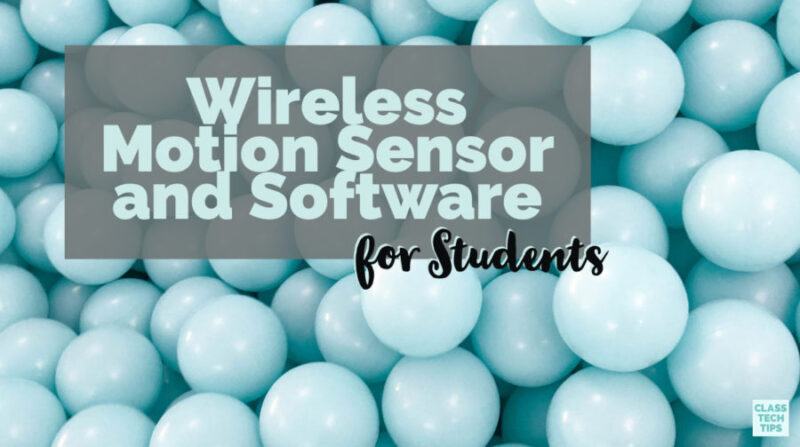Are you looking to engage students in problem-solving this school year? If you’re teaching math or science or supporting a teacher who is, you’ll want to check out the new PASCO Wireless Motion Sensor and MatchGraph! software. Whether you measure the motion of moving objects or objects in freefall, there are lots of ways to use this dynamic EdTech tool in your classroom!
When the folks at PASCO reached out to me this year, I was excited to learn more and get my hands on their new Wireless Motion Sensor. The Wireless Motion Sensor measures position, velocity, and acceleration of objects using ultrasound. Students in your class can participate in a variety of activities using this tool. They can measure themselves and watch their motion graphed in real-time or measure objects inside and outside of the classroom.
Wireless Motion Sensor
The PASCO Wireless Motion Sensor can detect objects from as close as 15 centimeters to as far away as four meters. Since the sensor is wireless, you and your students won’t have to worry about cables getting in the way. This feature can certainly provide a lot more flexibility as you design engaging learning experiences for students.

The Wireless Motion Sensor works with PASCO’s free MatchGraph! software. This software provides a way to teach a range of concepts to students. These concepts include motion graphing, how to interpret graphs and even rate of change and slope.
How does a wireless motion sensor work?
If you’re not familiar with this type of technology, let’s go through a quick overview. The Wireless Motion Sensor uses echolocation. This is a term we usually think of when talking about the ways that a dolphin or a bat communicates.
It uses an ultrasonic pulse emitted from the sensor. This feature lets the motion sensor listen for an ‘echo’ reflected back from the object’s surface. This is the way it can determine the distance to an object from the position of the person holding the PASCO Wireless Motion Sensor. The sensor uses the time of flight between the ultrasonic pulse to the echo (aka the speed of sound) to determine the distance to the object.
Motion Sensors in the Classroom
There are lots of ways to use the PASCO Wireless Motion Sensor, and your wheels might be spinning already! Students can use it to measure the motion of moving objects, to discover the relationship between position, velocity, and acceleration, or even measure objects in freefall. It can also help students measure how air resistance affects falling objects.
Your students might also use this technology as part of a problem-based learning activity where they measure objects to help solve a problem. Because this technology is designed for use in lots of different ways, you can tailor it to specific curriculum goals you have identified for an upcoming unit of study.
Students might use the PASCO Wireless Motion Sensor for a variety of investigations too. They can investigate frames of reference, investigate conservation of Energy and momentum of cart collisions, and even investigate simple harmonic motion. Depending on your particular curriculum goals, students might use the PASCO Wireless Motion Sensor to model seafloor mapping too.
Wireless Motion Sensor Features
There are a handful of unique features of the PASCO Wireless Motion Sensor worth mentioning. This sensor lets users report position, velocity, and acceleration. It also includes False Target Rejection Technology for clean data and clips directly to PASCO dynamics tracks. In addition to these features, there is also a rod clamp for mounting and a 180° pivoting head. The PASCO Wireless Motion Sensor includes a rechargeable lithium-ion battery and Bluetooth® or USB connectivity.
Motion Graphing Software
Do you teach motion graphing in your classroom math or science classroom? MatchGraph software can help students explore motion graphing. With MatchGraph, students can explore different curves and match one of the nine graphs accessible within the tool to see how accurately they match a chosen curve. The software can help students discover a deeper understanding of how to interpret graphs.
When students use a PASCO Wireless Motion Sensor, they can create graphs too. This will let them develop graphics of their own motion to analyze. You might use MatchGraph for teaching basic concepts of position and velocity, fundamental graphing skills, or even how position and velocity graphs relate to each other. This software is compatible with a handful of tools you might already use. This includes the PASCO Wireless Motion Sensor, PASCO Wireless Smart Cart, and the ScienceWorkshop Motion Sensor.
Ready to get started? Learn more about the PASCO Wireless Motion Sensor and MatchGraph software by heading over to their respective landing page. On the PASCO website, you can also learn about their other products. This includes lots of lab equipment items and resources to support teaching and learning in math and science this school year!







